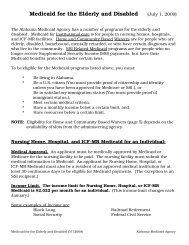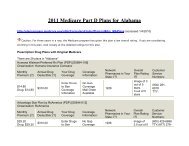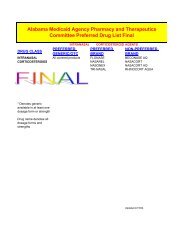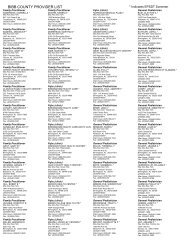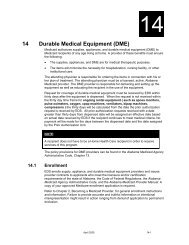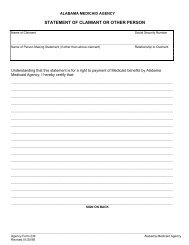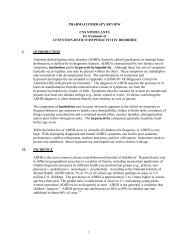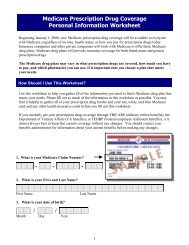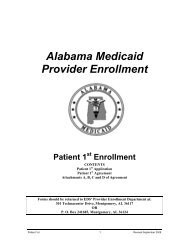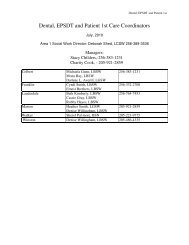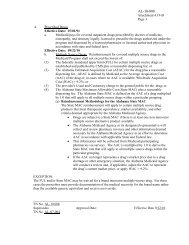Chapter 106 Targeted Case Management - Alabama Medicaid Agency
Chapter 106 Targeted Case Management - Alabama Medicaid Agency
Chapter 106 Targeted Case Management - Alabama Medicaid Agency
- No tags were found...
You also want an ePaper? Increase the reach of your titles
YUMPU automatically turns print PDFs into web optimized ePapers that Google loves.
<strong>106</strong><strong>106</strong> <strong>Targeted</strong> <strong>Case</strong> <strong>Management</strong><strong>Case</strong> management services are services that assist eligible individuals ingaining access to needed medical, social, educational and other services.<strong>Targeted</strong> <strong>Case</strong> <strong>Management</strong> (TCM) services assist specific eligible recipients,or targeted individuals, to access other services.<strong>Targeted</strong> <strong>Case</strong> <strong>Management</strong> services may be provided to recipients whoreside in their own home, the household of another, or in a supervisedresidential setting. No case management services will be provided torecipients in a hospital, skilled nursing facility, intermediate care facility,prison, jail, or other total care environment.<strong>Targeted</strong> <strong>Case</strong> <strong>Management</strong> services are provided to eligible recipients in thefollowing eight target groups:Target Group Recipients DescriptionTarget Group 1 Mentally ill adults <strong>Medicaid</strong>-eligible individuals age 18 and overwho have been diagnosed with mental illnessTarget Group 2Target Group 3Mentally retardedadultsHandicappedchildren<strong>Medicaid</strong>-eligible individuals age 18 and overwho have been diagnosed with mentalretardation<strong>Medicaid</strong>-eligible individuals age 0-21 who areconsidered handicappedTarget Group 4 Foster children <strong>Medicaid</strong>-eligible individuals age 0-21 who arein the care, custody, or control of the state of<strong>Alabama</strong>Target Group 5 Pregnant women <strong>Medicaid</strong>-eligible women of any age in need ofmaternity servicesTarget Group 6Target Group 7Target Group 8AIDS/HIV-positiveindividualsAdult protectiveservice individualsTechnologyAssisted (TA)Waiver for Adults<strong>Medicaid</strong>-eligible individuals of any age whohave been diagnosed as having AIDS or beingHIV-positive<strong>Medicaid</strong>-eligible individuals age 18 and overwho are at risk of abuse, neglect, orexploitation<strong>Medicaid</strong>-eligible individuals age 21 and overwho meet the eligibility criteria for the TAWaiverThe policy provisions for TCM providers can be found in the <strong>Alabama</strong><strong>Medicaid</strong> <strong>Agency</strong> Administrative Code, <strong>Chapter</strong> 40.January 2011 <strong>106</strong>-1
<strong>Targeted</strong> <strong>Case</strong> <strong>Management</strong><strong>106</strong>.1 EnrollmentProviders will submit a written request to the LTC Program <strong>Management</strong> Unitfor enrollment to the <strong>Targeted</strong> <strong>Case</strong> <strong>Management</strong> (TCM) Services Program.The request must contain the TCM target group to be covered: the name,address, and phone number of the provider agency; the name, address, andphone number of the payee (if different from the provider); the name andphone number of the contact person; and the tax ID number of the payee.Subcontract providers must have a contract with the primary provider. A copyof this contract will be submitted with the request to enroll as a TCM provider.A memo will be forwarded to the LTC Provider/Recipient Services Unit withthe assigned NPI, procedure code, and rate with the enrollment requestinformation. The Provider/Recipient Services Unit will submit a request toload the pricing file on Level I or Level III, as appropriate, to the Fiscal AgentLiaison. The Fiscal Agent Liaison will load the information to the pricing fileand submit the provider file to HP for enrollment.The LTC Provider/Recipient Services Unit will notify the Program<strong>Management</strong> Unit when the enrollment process has been completed. TheLTC Program <strong>Management</strong> Unit will notify the provider in writing of theeffective date of enrollment.Refer to <strong>Chapter</strong> 2, Becoming a <strong>Medicaid</strong> Provider, for general enrollmentinstructions and information. Failure to provide accurate and truthfulinformation or intentional misrepresentation might result in action ranging fromdenial of application to permanent exclusion.National Provider Identifier, Type, and SpecialtyA provider who contracts with <strong>Alabama</strong> <strong>Medicaid</strong> as a TCM provider is addedto the <strong>Medicaid</strong> system with the National Provider Identifiers provided at thetime application is made. Appropriate provider specialty codes are assignedto enable the provider to submit requests and receive reimbursements forcase management-related claims.NOTE:The 10-digit NPI is required when filing a claim.TCM providers are assigned a provider type of 21 (<strong>Targeted</strong> <strong>Case</strong><strong>Management</strong>). Valid specialties for TCM providers include the following:• Mentally Ill Adults (209)• Mentally Retarded Adults (229)• Handicapped Children (650)• Foster Child (217)• Pregnant Women (210)• AIDS/HIV Positive Individuals (211)• Adult Protective Services (640)• Technology Assisted (TA) Waiver Eligible Adults (590)<strong>106</strong>-2 January 2011
<strong>Targeted</strong> <strong>Case</strong> <strong>Management</strong> <strong>106</strong>Enrollment Policy for TCM ProvidersTo participate in the <strong>Alabama</strong> <strong>Medicaid</strong> Program, <strong>Targeted</strong> <strong>Case</strong><strong>Management</strong> providers must meet the following requirements:• Demonstrate the capacity to provide the core elements of casemanagement, including assessment, care and services plandevelopment, linking and coordination of services, and reassessment andfollow-up• Demonstrate case management experience in coordinating and linkingcommunity resources as required by the target population• Demonstrate experience with the target population• Provide the administrative capacity to ensure quality of services inaccordance with state and federal requirements• Maintain a financial management system that provides documentation ofservices and costs• Demonstrate the capacity to document and maintain individual caserecords in accordance with state and federal requirements• Demonstrate the ability to ensure a referral process consistent withSection 1902(a)23 of the Social Security Act, freedom of choice ofprovider• Demonstrate the capacity to meet the case management service needs ofthe target population• Provide an approved training program certified by <strong>Medicaid</strong> to addressthe needs and problems of the recipients served• Provide a quality assurance program for case management servicesapproved and certified by <strong>Medicaid</strong>. The quality assurance programincludes record reviews at a minimum of every six months.• Fully comply with Title VI and VII of the Civil Rights Act of 1964, Section504 of the Rehabilitation Act of 1973, the Age Discrimination Act of 1975,and the Americans with Disabilities Act of 1990• Fully comply with applicable federal and state laws and regulations<strong>106</strong>.1.1 Minimum Qualifications for Individual <strong>Targeted</strong><strong>Case</strong> ManagersIndividual <strong>Targeted</strong> <strong>Case</strong> Managers must meet the following minimumeducational qualifications:• Possess a Bachelor of Arts or a Bachelor of Science degree, preferably ina human services related field or social work program• Possess certification as a registered nurseIndividual <strong>Targeted</strong> <strong>Case</strong> Managers for Pregnant Women (Target Group 5),and AIDS/HIV-Positive Individuals (Target Group 6), must have a Bachelor ofArts or Bachelor of Science degree in social work from a school accredited bythe Council on Social Work Education.Individual <strong>Case</strong> Managers for Foster Children (Target Group 4) and AdultProtective Service individuals (Target Group 7) must be employed by DHRand meet the following qualifications:January 2011 <strong>106</strong>-3
<strong>Targeted</strong> <strong>Case</strong> <strong>Management</strong>• Possess a Bachelor of Arts or a Bachelor of Science degree, preferably ina human service field, or• Possess certification as a registered nurseIn addition to the minimum educational requirements, <strong>Targeted</strong> <strong>Case</strong>Managers must complete training in a case management curriculum approvedby <strong>Medicaid</strong> and other applicable state agencies. Specific requirements foreach target group are listed in the following paragraphs.<strong>106</strong>.1.2 Minimum Qualifications for Each Target GroupMinimum Qualifications for Target Group 1 ProvidersTCM providers for Mentally Ill Adults (Target Group 1) must meet theminimum educational qualifications listed in Section <strong>106</strong>. 1.1 and mustcomplete training in a case management curriculum approved by <strong>Medicaid</strong>and the Department of Mental Health and Mental Retardation.TCM providers for Mentally Ill Adults (Target Group 1) must be RegionalBoards incorporated under Act 310 of the 1967 <strong>Alabama</strong> Acts &Comprehensive Community Health Centers. TCM providers for Mentally IllAdults must be certified and provide services through a contract with theDepartment of Mental Health and Mental Retardation.Minimum Qualifications for Target Group 2 ProvidersTCM providers for Mentally Retarded Adults (Target Group 2) must meet theminimum educational qualifications listed in Section <strong>106</strong>. 1.1 and mustcomplete training in a case management curriculum approved by <strong>Medicaid</strong>and the <strong>Alabama</strong> Department of Mental Health and Mental Retardation.TCM providers for Mentally Retarded Adults (Target Group 2) must be eitherRegional Boards incorporated under Act 310 of the 1967 <strong>Alabama</strong> Acts &Comprehensive Community Health Centers who have demonstrated theability to provide targeted case management services directly, or the <strong>Alabama</strong>Department of Mental Health and Mental Retardation (DMH/MR). Providersmust be certified by the <strong>Alabama</strong> DMH/MR.Minimum Qualifications for Target Group 3 ProvidersTCM providers for Handicapped Children (Target Group 3) must meet theminimum qualifications listed in Section <strong>106</strong>.1.1 and must complete training ina case management curriculum approved by <strong>Medicaid</strong>.Minimum Qualifications for Target Group 4 ProvidersTCM providers for Foster Children (Target Group 4) must meet the minimumeducational qualifications listed in Section <strong>106</strong>.1.1 and must complete trainingin a case management curriculum approved by <strong>Medicaid</strong>.Minimum Qualifications for Target Groups 5 and 6 ProvidersTCM providers for Pregnant Women (Target Group 5) and AIDS/HIV-PositiveIndividuals (Target Group 6) must meet the minimum qualifications listed inSection <strong>106</strong>.1.1 and must complete training in a case management curriculumapproved by <strong>Medicaid</strong>.<strong>106</strong>-4 January 2011
<strong>Targeted</strong> <strong>Case</strong> <strong>Management</strong> <strong>106</strong>Minimum Qualifications for Target Group 7 ProvidersTCM providers for Adult Protective Services (Target Group 7) must meet theminimum educational qualifications listed in Section <strong>106</strong>.1.1 and mustcomplete training in a case management curriculum approved by <strong>Medicaid</strong>.<strong>Targeted</strong> <strong>Case</strong> <strong>Management</strong> Service Providers for Adult Protective ServiceIndividuals (Target Group 7) must demonstrate experience with the targetpopulation in investigating abuse, neglect, or exploitation in domestic settingsand in providing follow-up services to victims of abuse, neglect, orexploitation.Minimum Qualifications for Target Group 8 ProvidersTCM providers for Technology Assisted Waiver eligible adult individuals((Target Group 8) must meet the minimum qualifications listed in Section<strong>106</strong>.1.1 and must complete training in a case management curriculumapproved by <strong>Medicaid</strong>.<strong>106</strong>.2 Benefits and LimitationsThis section describes benefits and limitations for <strong>Targeted</strong> <strong>Case</strong><strong>Management</strong> providers. It contains the following subsections:• Core Elements of <strong>Targeted</strong> <strong>Case</strong> <strong>Management</strong>• Target Group Definitions• Documentation Requirements• Limitations<strong>106</strong>.2.1 Core Elements of <strong>Targeted</strong> <strong>Case</strong> <strong>Management</strong><strong>Case</strong> management services assist <strong>Medicaid</strong>-eligible recipients in gainingaccess to needed medical, social, educational, and other services. The casemanager provides these services through telephone contact with recipients,face-to-face contact with recipients, telephone contact with collaterals, orface-to-face contact with collaterals. Collaterals are the <strong>Medicaid</strong>-eligibleclient’s immediate family and/or guardians, federal, state, or local serviceagencies (or agency representatives), and local businesses who work with thecase manager to assist the recipient.<strong>Targeted</strong> <strong>Case</strong> <strong>Management</strong> services consist of the following six coreelements, which are defined in the paragraphs that follow:• Needs assessment• <strong>Case</strong> planning• Service arrangement• Social support• Reassessment and follow-up• MonitoringJanuary 2011 <strong>106</strong>-5
<strong>Targeted</strong> <strong>Case</strong> <strong>Management</strong>Needs assessmentA TCM provider performs a written comprehensive assessment of therecipient’s assets, deficits, and needs. The TCM provider gathers thefollowing information:• Identifying information• Socialization and recreational needs• Training needs for community living• Vocational needs• Physical needs• Medical care concerns• Social and emotional status• Housing and physical environment• Resource analysis and planning<strong>Case</strong> planningTCM providers must develop a systematic, recipient-coordinated plan of carethat lists the actions required to meet the identified needs of the recipientbased on the needs assessment. The plan is developed through acollaborative process involving the recipient, his family or other supportsystem, and the case manager. It must be completed in conjunction with theneeds assessment within the first 30 days of contact with the recipient.Service arrangementThrough linkage and advocacy, the case manager coordinates contactsbetween the recipient and the appropriate person or agency. These contactsmay be face to face, phone calls, or electronic communication.Social SupportThrough interviews with the recipient and significant others, the case managerdetermines whether the recipient possesses an adequate personal supportsystem. If this personal support system is inadequate or nonexistent, the casemanager assists the recipient in expanding or establishing such a networkthrough advocacy and linking the recipient with appropriate persons, supportgroups, or agencies.Reassessment and Follow-upThrough interviews and observations, the case manager evaluates therecipient’s progress toward accomplishing the goals listed in the case plan atintervals of six months or less. In addition, the case manager contactspersons or agencies providing services to the recipient and reviews theresults of these contacts, together with the changes in the recipient’s needsshown in the reassessments, and revises the case plan if necessary.<strong>106</strong>-6 January 2011
<strong>Targeted</strong> <strong>Case</strong> <strong>Management</strong> <strong>106</strong>MonitoringThe case manager determines what services have been delivered andwhether they adequately meet the needs of the recipient. The plan of caremay require adjustments as a result of monitoring.<strong>106</strong>.2.2 Target Group DefinitionsThis section defines the eight target groups served by TCM providers.Target Group 1 – Mentally Ill AdultsTarget Group 1 consists of functionally limited individuals age 18 and overwith multiple needs who require mental health case management. Suchpersons have a DSM-III-R diagnosis (other than mental retardation orsubstance abuse), impaired role functioning, and a documented inability toindependently access and sustain involvement with needed services.Target Group 2 – Mentally Retarded AdultsTarget Group 2 consists of individuals who are 18 years of age or older with adiagnosis of mental retardation, as defined by the American Association ofMental Retardation (formerly AAMD). The individual’s diagnosis must bedetermined by a Qualified Mental Retardation Professional (QMRP) and mustinclude a primary determination of both intellectual and adaptive behaviorsindicating the individual's primary problems are due to mental retardation.Such persons may have other or secondary handicapping conditions.Target Group 3 – Handicapped ChildrenTarget Group 3 consists of individuals, age 0-21 considered to behandicapped as defined in the following six subgroups:• Mentally retarded/related conditions• Seriously emotionally disturbed• Sensory impaired• Disabling health condition(s)• Developmentally delayed• Multi-handicappedMentally Retarded/Related ConditionsAll recipients in this subgroup must be age 0-17. A recipient is consideredmentally retarded when a diagnosis of mental retardation is determined. Thisdetermination must include a primary determination of both intellectual andadaptive behaviors indicating the individual's primary problems are due tomental retardation.January 2011 <strong>106</strong>-7
<strong>Targeted</strong> <strong>Case</strong> <strong>Management</strong>Recipients with related conditions are individuals who have a severe chronicdisability described by all of the following criteria:• Attributable to Cerebral palsy or epilepsy; or any other condition, otherthan mental illness, found to be closely related to mental retardationbecause this condition results in impairment of general intellectualfunctioning or adaptive behavior similar to that of mentally retardedpersons, and requires treatment or services similar to those required forthese persons• Likely to continue indefinitely• Results in substantial functional limitations in three or more of thefollowing areas of major life activity:−−−−−Self-careUnderstanding and use of languageLearningMobilitySelf-direction or capacity for independent livingSeriously Emotionally DisturbedA recipient is considered seriously emotionally disturbed if they meet at leastone criterion from column 1, Mental Health Treatment History, or 2, Indicatorsor Mental Health Treatment Needs, and two criteria from column 3, CurrentFunctioning Problem Areas.Mental Health TreatmentHistoryHas undergone mentalhealth treatment moreintensive than outpatientcare (emergency servicesor inpatient services)Has experiencedstructured, supportiveresidential treatment, otherthan hospitalization, for atotal of at least two monthsin their lifetimeHas been assigned to aprogram of psychotropicmedicationHas received mental healthoutpatient care for a periodof at least six months, or formore than 20 sessions, orhas been admitted fortreatment on two or moreoccasionsIndicators of Mental HealthTreatment NeedsFamily history of alcohol or drugabuseFamily history of mental healthtreatmentFailure to thrive in infancy orearly development indicated inmedical recordsVictim of child abuse, neglect,or sexual abusePervasive or extreme acts ofaggression against self, others,or property (homicidal orsuicidal gestures, fire setting,vandalism, or theft)Runaway episode(s) of at least24 hours’ durationCurrent FunctioningDoes not attend school (andhas not graduated), is enrolledin a special educationcurriculum, or has poor gradesDysfunctional relationship withfamily and peersRequires help in basic, ageappropriateliving skillsExhibits inappropriate socialbehaviorExperiences seriousdiscomfort from anxiety,depression, irrational fears,and concerns (indicated byserious eating or sleepingdisorders, extreme sadness,or social isolation)<strong>106</strong>-8 January 2011
<strong>Targeted</strong> <strong>Case</strong> <strong>Management</strong> <strong>106</strong>NOTE:Consider current functioning problem areas of one-year duration or withsubstantial risk of over one year duration.Sensory ImpairedBlind recipients have no usable vision after the best possible correction. Theymust rely on tactile and auditory senses to obtain information.Partially sighted recipients have a visual acuity of 20/70 or less in the bettereye with the best possible correction. They also have a peripheral field sorestricted that it affects their ability to learn, or a progressive loss of visionwhich may in the future affect their ability to learn.Deaf recipients have a hearing impairment that is so severe that they areimpaired in processing linguistic information through hearing, with or withoutamplification. This impairment adversely affects educational performance.Blind multihandicapped recipients have a visual impairment (either blind orpartially sighted as defined above) and a concurring handicapping condition.Deaf multihandicapped recipients have a hearing impairment (deaf as definedabove) and a concurring handicapping condition.Deaf-blind recipients have both hearing and visual impairments. Thecombination of sensory impairments causes such severe communication andother developmental and educational problems that the recipient cannot beproperly accommodated in the educational programs offered by the <strong>Alabama</strong>School for the Blind or the <strong>Alabama</strong> School for the Deaf.Disabling Health Condition(s)Recipients are eligible for <strong>Targeted</strong> <strong>Case</strong> <strong>Management</strong> services if they havethe following disabling conditions, which are severe, chronic, and physical innature and require extensive medical and habilitative/rehabilitative services.• Central nervous system dysraphic states such as spina bifida,hydranencephaly, and encephalocele• Cranio-facial anomalies such as cleft lip and palate, Apert's syndrome,and Crouzon's syndrome• Pulmonary conditions such as cystic fibrosis• Neuro-muscular conditions such as cerebral palsy, arthrogryposis, andjuvenile rheumatoid arthritis• Seizure disorders such as those poorly responsive to anticonvulsanttherapy and those of mixed seizure type• Hematologic/immunologic disorders such as hemophilia, sickle celldisease, aplastic anemia, and agammaglobulinemia• Heart conditions such as aortic coarctation, and transposition of the greatvessels• Urologic conditions such as extrophy of bladder• Gastrointestinal conditions such as Hirschsprung's Disease, omphalocele,and gastroschisisJanuary 2011 <strong>106</strong>-9
<strong>Targeted</strong> <strong>Case</strong> <strong>Management</strong>• Orthopedic problems such as clubfoot, scoliosis, fractures, andpoliomyelitis• Metabolic disorders such as panhypopituitarism• Neoplasms such as leukemia, and retinoblastoma• Multisystem genetic disorders such as tuberosclerosis, andneurofibromatosisDevelopmentally DelayedA child age birth to three years is eligible for TCM services if they areexperiencing developmental delays greater than or equal to 25 percent asmeasured by appropriate diagnostic instruments and procedures in one ormore of the following areas:• Cognitive development• Physical development, including vision and hearing• Language and speech development• Psychosocial development• Self-help skillsA recipient is also eligible if they have been diagnosed with a physical ormental condition that has a high probability of resulting in a developmentdelay.MultihandicappedAn individual who has a combination of two or more handicapping conditionsas described above is considered multi-handicapped. Each condition, ifconsidered separately, might not be severe enough to warrant casemanagement, but a combination of the conditions adversely affectsdevelopment.Target Group 4 – Foster ChildrenTarget Group 4 consists of children age birth to 21 who receive preventive,protective family preservation or family reunification services from the State,or any of its agencies, as a result of State intervention or upon application bythe child's parent(s), custodian(s), or guardian(s).The group also consists of children age birth to 21 who are in the care,custody, or control of the State of <strong>Alabama</strong>, or any of its agencies, due to oneof the following three situations.• The judicial or legally sanctioned determination that the child must beprotected by the State as dependent, delinquent, or a child in need ofsupervision as those terms are defined by the <strong>Alabama</strong> Juvenile Code,Title 12, <strong>Chapter</strong> 15, Code of <strong>Alabama</strong> 1975<strong>106</strong>-10 January 2011
<strong>Targeted</strong> <strong>Case</strong> <strong>Management</strong> <strong>106</strong>• The judicial determination or statutorily authorized action by the State toprotect the child from actual or potential abuse under the <strong>Alabama</strong>Juvenile Code, Title 26, <strong>Chapter</strong> 14, Code of <strong>Alabama</strong> 1975, or otherstatute• The voluntary placement agreement, voluntary boarding houseagreement, or an agreement for foster care, between the State and thechild's parent(s), custodian(s), or guardianTarget Group 5 – Pregnant WomenTarget Group 5 consists of <strong>Medicaid</strong>-eligible women of any age in need ofmaternity services.Target Group 6 – AIDS/HIV-Positive IndividualsTarget Group 6 consists of <strong>Medicaid</strong>-eligible individuals of any age who havebeen diagnosed with AIDS or are HIV-positive as evidenced by laboratoryfindings.Target Group 7 – Adult Protective Service IndividualsTarget Group 7 consists of individuals 18 years of age or older who meeteither of the following criteria:• At risk of abuse, neglect, or exploitation• At risk of institutionalization due to their inability or their caretaker'sinability to provide the minimum sufficient level of care in the homeTarget Group 8 - Technology Assisted (TA) Waiver for AdultsTarget Group 8 individuals consist of <strong>Medicaid</strong> eligible individuals age 21 andolder, who meet the eligibility criteria for the Technology Assisted (TA) Waiverfor Adults.<strong>106</strong>.2.3 Documentation RequirementsThe TCM provider must make available to <strong>Medicaid</strong> at no charge allinformation describing services provided to eligible recipients. The providermust also permit access to all records and facilities for the purpose of claimsaudit, program monitoring, and utilization review by duly authorizedrepresentatives of Federal and State agencies.The TCM provider must maintain complete and accurate medical, psychiatricand fiscal records that fully disclose the extent of the service. The recordsshall be retained for three years plus the current year to substantiate that theservices billed to <strong>Medicaid</strong> were actually delivered to the <strong>Medicaid</strong> recipientand to substantiate the charges billed to <strong>Medicaid</strong>. However, if audit, litigation,or other legal action by or on behalf of the state or federal government hasbegun but is not completed at the end of the three year period, the TCMprovider must retain the records until resolution.Record retention for TCM files will remain three years plus the current year.Records for TCM provided through waivers shall be retained for three yearsduring the initial waiver period and five years after renewal of the waivers.January 2011 <strong>106</strong>-11
<strong>Targeted</strong> <strong>Case</strong> <strong>Management</strong>Provider’s records must contain the following information:• Name of recipient• Dates of service• Name of provider agency and person providing services• Nature, extent, or units of services provided• Place of serviceTCM providers must maintain the following documentation in the recipient'srecord when billing for Foster Children (Target Group 4) and Adult ProtectiveService Individuals (Target Group 7):• A current comprehensive service plan that identifies the medical,nutritional, social, educational, transportation, housing and other serviceneeds that have not been adequately accessed• A time frame to reassess service needsServices must consist of at least one of the following activities:• Establishment of a comprehensive case file for development andimplementation of an individualized service plan to meet the assessedservice needs of -the recipient• Assistance for the recipient in locating needed service providers andmaking the necessary linkages to assure the receipt of services identifiedin the service plan• Assessment of the recipient and service providers to determine that theservices received are adequate in meeting the identified needs• Reassessment of the recipient to determine services needed to resolveany crisis situation resulting from changes in the family structure, livingconditions, or other eventsSocial Services Work Sampling StudyFor Target Group 4 (Foster Children) and Target Group 7 (Adult ProtectiveService Individuals), reimbursement rates are based on cost as determinedby the quarterly Social Services Work Sampling Study. Rates will be adjustedannually based on the results of the previous four quarters. Random MomentSampling may not be used as a method of documenting services provided torecipients. The Work Sampling Study must provide an audit trail that identifieseach client whose case is included in the data used for rate formulation andidentifies that services have been provided.<strong>106</strong>.2.4 LimitationsFor Target Group 4 (Foster Children) and Target Group 7 (Adult ProtectiveService Individuals), an encounter rate consisting of a maximum of one unit ofcase management services will be reimbursed per month for each eligiblerecipient receiving case management services. A unit of case managementservice consists of at least one telephone or face-to-face contact with therecipient, a family member, significant other, or agency from which the clientreceives or may receive services.For all other target groups, a unit of service is reimbursed in increments of fiveminutes.<strong>106</strong>-12 January 2011
<strong>Targeted</strong> <strong>Case</strong> <strong>Management</strong> <strong>106</strong>The case manager must document all contacts in the recipient’s record.Contacts must be for the coordination of services for a specific identifiedrecipient.Recipients receiving case management services through a waiver are noteligible for targeted case management.<strong>Case</strong> management services for mentally retarded adults are provided toindividuals with a diagnosis of mental retardation who are 18 years of age orolder.<strong>Case</strong> management services for all other target groups are not limited to amaximum number of hours per calendar year.<strong>106</strong>.3 Prior Authorization and Referral RequirementsTCM procedure codes generally do not require prior authorization, except forthe target groups noted below.TCM providers must obtain prior authorization from HP to avoid duplicatepayments for targeted case management services in the following targetgroups:• Handicapped Children (Target Group 3)• Foster Children (Target Group 4)Direct all inquiries and requests relating to prior authorization for a specifictarget group to HP’ Provider Communication Unit at 1(800) 688-7989.Interagency TransfersIf a recipient in a target group requiring prior authorization requests to changecase managers from one agency to another, the TCM provider must completea Request for Interagency Transfer form. This form authorizes HP to reassignthe prior authorization number to the receiving agency providing thecontinuation of case management services. Obtain the Request forInteragency Transfer forms from the <strong>Alabama</strong> <strong>Medicaid</strong> <strong>Agency</strong>, 501 DexterAvenue, P.O. Box 5624, Montgomery, AL 36103-5624.<strong>106</strong>.4 Cost Sharing (Copayment)The copayment does not apply to services provided for targeted casemanagement.<strong>106</strong>.5 Completing the Claim FormTo enhance the effectiveness and efficiency of <strong>Medicaid</strong> processing,providers should bill <strong>Medicaid</strong> claims electronically.TCM providers who bill <strong>Medicaid</strong> claims electronically receive thefollowing benefits:• Quicker claims processing turnaround• Ability to immediately correct claim errors• Online adjustments capability• Enhanced access to eligibility information‣Electronicclaimssubmissioncan save youtime andmoney. Thesystem alertsyou tocommon errorsand allows youto correct andresubmitclaims online.January 2011 <strong>106</strong>-13
<strong>Targeted</strong> <strong>Case</strong> <strong>Management</strong>Refer to Appendix B, Electronic Media Claims Guidelines, for moreinformation about electronic filing.NOTE:When filing a claim on paper, a CMS-1500 claim form is required. Medicarerelatedclaims must be filed using the Medical <strong>Medicaid</strong>/Medicare RelatedClaim Form.This section describes program-specific claims information. Refer to <strong>Chapter</strong>5, Filing Claims, for general claims filing information and instructions.<strong>106</strong>.5.1 Time Limit for Filing Claims<strong>Medicaid</strong> requires all claims for TCM providers to be filed within one year ofthe date of service. Refer to Section 5.1.5, Filing Limits and ApprovedExceptions, for more information regarding timely filing limits and exceptions.<strong>106</strong>.5.2 Diagnosis CodesSee Section <strong>106</strong>.5.3 (Procedure Codes and Modifiers) for the allowablediagnosis codes. The International Classification of Diseases - 9th Revision -Clinical Modification (ICD-9-CM) manual lists required diagnosis codes.These manuals may be obtained by contacting the American MedicalAssociation, P.O. Box 10950, Chicago, IL 60610.NOTE:ICD-9 diagnosis codes must be listed to the highest number of digits possible(3, 4, or 5 digits). Do not use decimal points in the diagnosis code field.<strong>106</strong>.5.3 Procedure Codes and ModifiersTCM providers use the Current Procedural Terminology (CPT) coding system.The CPT manual lists most required procedure codes. This manual may beobtained by contacting the Order Department, American Medical Association,515 North State Street, Chicago, IL 60610-9986. The (837) Professional andinstitutional claims and the paper claim have been modified to accept up tofour Procedure Code Modifiers.The following procedure codes, modifiers, and diagnosis codes apply whenfiling claims for TCM services:Target GroupProcedureCodeDiagnosis Code5 (Pregnant Women G9008-HD V220 – V242V270 – V289V3100 – V3900630 – 63263300 – 6339163400 – 637926380 – 639964000 – 6419364200 – 6429464300 – 6439364400 – 64421PA Required?No<strong>106</strong>-14 January 2011
<strong>Targeted</strong> <strong>Case</strong> <strong>Management</strong> <strong>106</strong>Target GroupProcedureCodeDiagnosis Code64510 – 6460364610 – 6462464630 – 6463164640 – 6466464670 – 6467364680 – 6468464690 – 6469364700 – 6489465100 – 6539365400 – 6549465500 – 6639366400 – 676942 MR Adults G9008-U2 317 – 319 NoPA Required?1 MI Adults G9008-U1 29500 – 2959529600 – 296662967 – 296729680 – 296992970 – 298929900 – 2999130000 – 300293003 – 300730081 – 300893009 – 301030110 – 3011330120 – 301223013 – 301430150 – 301593016 – 301730181 – 301893019 - 3019No3 MR Child G9005-U3 319 Yes3 SED Child G9002-U3 3009 Yes3 Sensory Impaired G9008-U3 78199 YesChild3 Disabling Health G9008-U3 780 YesChild3 Multi Handicapped G9008-U3 7429 YesChild4 Foster Child T2023-U4 2999 Yes6 AIDS/G9012-U6 042NoHIV079533 DD Child G9006-U3 3159 Yes8 TA Waiver G9008-U5 V550 No7 APSI T2023-U7 797 NoJanuary 2011 <strong>106</strong>-15
<strong>Targeted</strong> <strong>Case</strong> <strong>Management</strong><strong>106</strong>.5.4 Place of Service CodesThe following place of service codes apply when filing claims for TCMservices:POS CodeDescription11 Office12 Home24 Ambulatory Surgical Center33 Custodial Care Facility52 Psychiatric Facility Partial Hospitalization53 Community Mental Health Center62 Comprehensive Outpatient Rehabilitation Facility71 State or Local Public Health Clinic81 Independent Laboratory<strong>106</strong>.5.5 Required AttachmentsThere are no required attachments for <strong>Targeted</strong> <strong>Case</strong> <strong>Management</strong> providers.<strong>106</strong>.6 For More InformationThis section contains a cross-reference to other relevant sections in themanual.ResourceWhere to Find ItCMS-1500 Claim Filing Instructions Section 5.2Patient 1 st <strong>Chapter</strong> 39Electronic Media Claims (EMC) GuidelinesAppendix BAVRS Quick Reference GuideAppendix L<strong>Alabama</strong> <strong>Medicaid</strong> Contact InformationAppendix N<strong>106</strong>-16 January 2011




